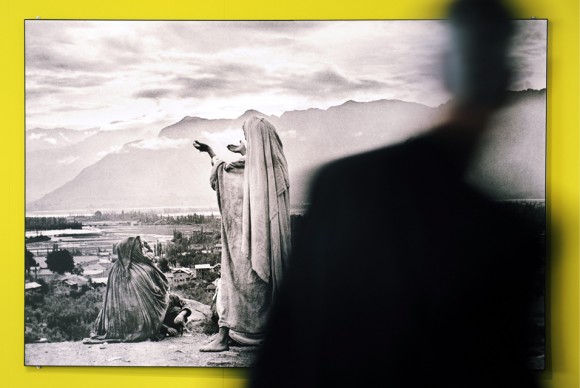The Museum for Arts and Crafts in Zurich Presents Henri Cartier-Bresson Retrospective
ZURICH- Henri Cartier-Bresson is one of the most important photographers in history. The Museum für Gestaltung Zürichpays tribute to his achievements in a comprehensive retrospective that is the first of its kind to be seen in Switzerland. The exhibition is on view from April 8 through July 24, 2011.
Henri Cartier-Bresson (1908–2004) is among the most influential and most admired photographers. Even his first works from the early 1930s stand out on account of their exceptional qualities in terms of composition, the view selected and the dramaturgy of the images. Like no-one else Cartier-Bresson succeeded in recording the decisive moment, in his works entire stories are often condensed in a single picture. Together with photographer friends such as Robert Capa he set up the Magnum Agency in 1947 which launched the heyday of photo-journalism and today still represents photographers’ rights with regard to their images. As a photo reporter and artist Cartier-Bresson decisively influenced magazines such as “Du” or “Life”. Work on reports of historical moments brought him to the Soviet Union and Asia. He had a seminal influence not only on photojournalism of the 20th century but also on the aesthetics and ethics of photography in general.

A visitor walks past a photograph by French photographer Henri Cartier-Bresson at an exhibition at the Museum for Arts and Crafts in Zurich, Switzerland. The retrospective of Cartier-Bresson (1908–2004) brings together around 300 photographs along with his films and important publications for the first time ever in Switzerland. The exhibition lasts until July 24, 2011. AP Photo/Keystone, Walter Bieri.
The Exhibition
This first comprehensive exhibition in Switzerland since 1956 (in the Museum für Gestaltung Zürich at that time) presents works from the entire photographic oeuvre of Henri Cartier-Bresson. Around 300 of his world-renowned works are combined with Cartier-Bresson’s films, many of his publications, and the important “Scrap Book” (in facsimile) from 1946. In addition on certain days the retrospective offers concerts in which Cartier-Bresson’s favorite music is performed – with piano matinees and jazz trios and in close collaboration with the music department of the Zurich University of the Arts (ZHdK).
The layout of the exhibition is organised according to the path taken by Cartier-Bresson’s life and starts with the films from the Spanish Civil War and his early works in Mexico. After his main film “Le Retour” – a report about the difficult homecoming of prisoners of war after the Second World War – visitors proceed to the “Scrap Book”, a selection of his best works that Cartier-Bresson compiled in 1946 especially for MoMA New York.
After the war Cartier-Bresson was able to quickly establish himself as a portrait and reportage photographer: a photo-report about America leads visitors onwards to his years in Asia. There he was witness to epoch-defining moments in history, such as Gandhi’s murder in India, the first days of communist rule in China or the collapse of colonialism in Indonesia. In addition Cartier-Bresson was the very first Western photo-reporter to travel throught the former Soviet Union.
The exhibition shows not only the films and photographs of Cartier-Bresson but also the context in which they were used. Numerous series of photographs from magazines such as “Du” or “Life” round off the exhibition to provide an overall view of the photographer about whom Richard Avedon said in 2000: “He is the most complete and most important of us, from every point of view. Whether social or political – he covered everything. He is simply the best photographer of the 20th century.”
The Biography
Henri Cartier-Bresson was born in France on 22 August 1908. After studying painting in the 1920s Cartier-Bresson, who came from a well-to-do industrialist family, devoted himself to photography from 1930 onwards. His first travels took him to Africa, Europe and America, after his return to France his first film work with Jean Renoir followed. In 1940 he was captured by the Germans and remained a prisoner-of-war for almost three years. His third attempt to escape was successful and he returned to France. After it had been wrongly assumed that he had died in the war the MoMA New York devoted a major “posthumous” exhibition to Cartier Bresson in 1947. In the same year he set up the legendary Magnum photo agency with Robert Capa, David Seymour and George Rodger. Further travels took him to, among other places, India, Pakistan, Cuba, China, Indonesia the USA and the Soviet Union. In 1955 his work was exhibited in France for the first time, in the Louvre. In 1974 he laid his camera aside and devoted himself to drawing. Together with his wife Martine Franck he set up the Fondation Henri Cartier-Bresson in 2003. In August 2004 Henri Cartie r-Bresson died in France.
Related posts:
- SFMOMA Presents Major U.S. Retrospective of Photographer Henri Cartier-Bresson
- Art Institute of Chicago Opens Henri Cartier-Bresson Retrospective
- LA Art Show Debuts Never-Before Seen Works by Photographer Henri Cartier-Bresson
- MoMA Announces a New Overview of Henri Cartier-Bresson’s Panoramic Career
- High Museum to Host Retrospective of Iconic 20th Century Photographer Henri Cartier-Bresson
